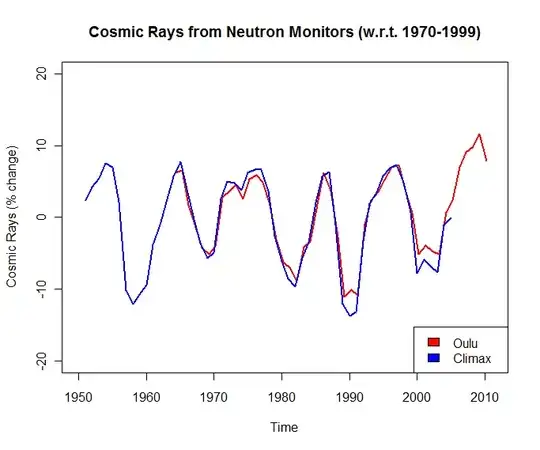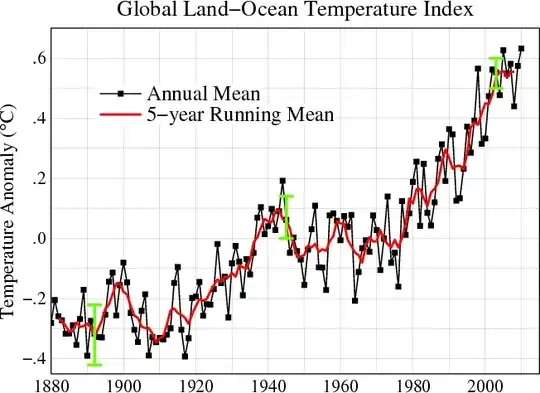Yes!
TL;DR - Several experiments at the CLOUD lab show that cosmic and human contributions are inadvertently reducing the impact of CO2 emissions.
Hydrocarbon emissions - Experiments show that sulfuric acid in the atmosphere increases cloud cover much more than we thought before. Therefore the use of cleaner fuels may well be warming the earth.
Cosmic rays - Experiments show that many places on the earth's surface are subject to the formation of clouds by cosmic rays. Therefore astronomic cycles like the sunspot cycles must not be ignored when making climate models.
Bonus: Low tide - Researchers know that algae that dries out during low tide releases chemicals that cause the formation of clouds. Therefore the moon's cycles (such as supermoons) must not be ignored when making climate models.
Long Form
Back in August 2011, a study conducted at CERN in Switzerland published its first findings, which found that...
ionisation from cosmic rays significantly enhances aerosol formation. Precise measurements such as these are important in achieving a quantitative understanding of cloud formation, and will contribute to a better assessment of the effects of clouds in climate models.
The IPCC 2013 report repeated this concern:
Changing cloud amount of properties modify the Earth's albedo and therefore affect climate. It has been hypothesized that cosmic ray flux create atmospheric ions which facilitates aerosol nucleation and new particle formation with a further impact on cloud formation (Dickinson 1975; Kirkby, 2007). ... However, there is high confidence (medium evidence and high agreement) that the cosmic ray-ionization mechanism is too weak to influence global concentrations of cloud condensation nuclei or their change over the last century or during a SC in a climatically significant way...
We asked at the time:
how "big a deal" are these results? If the findings are duplicated, would they imply dramatic changes in the models that predict global warming?
The answers that came were in the "wait and see" category, since there was still too little that we were sure about. Now, after seven years have passed (and the CLOUD laboratory has not slowed down) let's see what the scientists are saying:
Sulfuric Acid
New particle formation in the sulfuric acid–dimethylamine–watersystem: reevaluation of CLOUD chamber measurements and comparison to an aerosol nucleation and growth model
Andreas Kürten & Chenxi Li et al, Jan 23, 2018
New particle formation rates [i.e. cloud cover effects] from CLOUD chamber measurements for the sulfuric acid-DMA-water system were re-analyzed. It was found that the previously published rates by Almeida et al. (2013) underestimate the NPF rates [i.e. cloud cover effects] by up to a factor of ~50 at high sulfuric acid concentrations (~1 X 10^7 cm^-3).
However:
... Only one study has so far reported sulfuric acid–amine nucleation (Zhao et al., 2011). The nucleation of sulfuric acid–amines could, however, occur more often than currently thought.
This correction means that previous estimates of the cloud-forming effects of sulfuric acid may have been way too low, and that it would have been incorrect to dismiss such effects from major climate models. Another recent CLOUD study has this to say:
Measurement–model comparison of stabilized Criegee intermediate and highly oxygenated molecule production in the CLOUD chamber
Nina Sarnela & Tuija Jokinen et al, Feb 19, 2018
The results indicate that the CLOUD experiments on α-pinene ozonolysis support the recently published chemistry of HOM and sCI [i.e. stabilized Criegee intermediates] formation, thus making the experimentally determined yield and loss terms more reliable for modelling and theoretical use.
So what do HOMs and sCIs tell us? Well:
Elucidating the molecular mechanisms of Criegee-amine chemistry in the gas phase and aqueous surface environments
Manoj Kumar & Joseph S. Francisco, Oct 24, 2018
Though the Criegee-ammonia reactions have been found to be tropospherically insignificant, the facile nature of Criegee-dimethylamine reactions suggests that these chemistries may play a role in the new particle forming events [i.e. cloud cover effects] under certain conditions [such as in California's central valley, New York City and Paris] and thus, need to be updated in the existing atmospheric models.
(emphasis by Elliot)
So since Kumar et al (2018) was published, there have been about four months during which climate scientists could have been updating their existing atmospheric models to account for a newly-verified source of sulfuric acid cloud-forming events, which as Kürten et al (2018).
Cosmic Rays
Ion-induced nucleation of pure biogenic particles
Jasper Kirkby, Jonathan Duplissy & Kamalika Sengupta et al, May 26, 2016
Atmospheric aerosols and their effect on clouds are thought to be important for anthropogenic radiative forcing of the climate, yet remain poorly understood. ... We find that ions from Galactic cosmic rays increase the nucleation rate by one to two orders of magnitude compared with neutral nucleation. Our experimental findings are supported by quantum chemical calculations of the cluster binding energies of representative HOMs. Ion-induced nucleation of pure organic particles constitutes a potentially widespread source of aerosol particles in terrestrial environments with low sulfuric acid pollution.
This was reviewed by various other researchers... as of today, it has been cited 189 times according to Google Scholar. V. Faye McNeill wrote in 2017 that "Significant progress has been made over the past two decades in understanding atmospheric aerosol chemistry and its connections to climate.". Here's one follow-up paper:
Reduced anthropogenic aerosol radiative forcing caused by biogenic new particle formation
Hamish Gordon, Kamalika Sengupta & Alexandru Rap et al, October 25, 2016
A mechanism for the formation of atmospheric aerosols via the gas to particle conversion of highly oxidized organic molecules is found to be the dominant aerosol formation process in the preindustrial boundary layer over land. The inclusion of this process in a global aerosol model raises baseline preindustrial aerosol concentrations and could lead to a reduction of 27% in estimates of anthropogenic aerosol radiative forcing.
Note that biogenic refers to the particles of the mechanism that's dominant for cleaner air mixtures in places like the Amazon rain forest and the southern hemisphere, and also pre-industrial unpolluted air.
How does aerosol forcing compare with greenhouse gas forcing? According to Climate Forcing by Anthropogenic Aerosols, Charlson & Schwartz et al, 1992, "Current climate forcing due to anthropogenic sulfate is estimated to be ... is comparable in magnitude to current anthropogenic greenhouse gas forcing but opposite in sign."
For those of you in the audience who are keeping score, this means that any reduction in an estimate of anthropogenic aerosol forcing increases the effect of anthropogenic greenhouse gas forcing. But that says nothing of the effect of cosmic rays.
Finally, here we read:
Unexpected player in particle formation
Chris Cappa, May 26, 2016
"Three studies find that a family of organic compounds affects the formation and initial growth of atmospheric aerosol particles in clean air — with implications for our knowledge of the climate effects of aerosols."
Tidal Effects
Measurement–model comparison of stabilized Criegee intermediate and highly oxygenated molecule production in the CLOUD chamber
Nina Sarnela, Tuija Jokinen and Jonathan Duplissy et al. Aug 22, 2017
Field studies suggest that iodine oxides could be the key compounds for new particle formation in coastal areas during periods when high tidal movements expose algae beds to sunlight (O'Dowd et al., 2002; Sipilä et al., 2016). However, these iodine oxides do not appear as abundantly in the atmosphere as sulfuric acid or low-volatility organic vapours, so their importance seem to be limited to coastal areas.
Final Comments
Beyond Equilibrium Climate Sensitivity
Reto Knutti, Maria A. A. Rugenstein & Gabriele C. Hegerl
Nature Geoscience volume 10, pages 727–736 (2017)
Equilibrium climate sensitivity characterizes the Earth's long-term global temperature response to increased atmospheric CO2 concentration. It has reached almost iconic status as the single number that describes how severe climate change will be. The consensus on the 'likely' range for climate sensitivity of 1.5 °C to 4.5 °C today is the same as given by Jule Charney in 1979, but now it is based on quantitative evidence from across the climate system and throughout climate history. The quest to constrain climate sensitivity has revealed important insights into the timescales of the climate system response, natural variability and limitations in observations and climate models, but also concerns about the simple concepts underlying climate sensitivity and radiative forcing, which opens avenues to better understand and constrain the climate response to forcing. Estimates of the transient climate response are better constrained by observed warming and are more relevant for predicting warming over the next decades. Newer metrics relating global warming directly to the total emitted CO2 show that in order to keep warming to within 2 °C, future CO2 emissions have to remain strongly limited, irrespective of climate sensitivity being at the high or low end.
In summarizing experiments such as the CLOUD experiments in 2017, Knutti et al acknowledge that CO2 is not the only important factor for climate change, and also other mitigating facts that should hedge extrapolations of future climate change. These mitigating facts include "timescales of the climate system response, natural variability and limitations in observations and climate models" as well as "concerns about the simple concepts underlying climate sensitivity and radiative forcing". Considering that radiative forcing is human-caused or cosmic-caused cooling cloud cover, these researchers acknowledge that YES: recent CLOUD experiments do have significant implications for global warming.
In the judgment of Knutti et al, limiting CO2 is a good goal to set irrespective of how bad it is for the climate. That's why they say that CO2 emissions have to remain strongly limited. But this is a judgment call rather than an experimental result.

